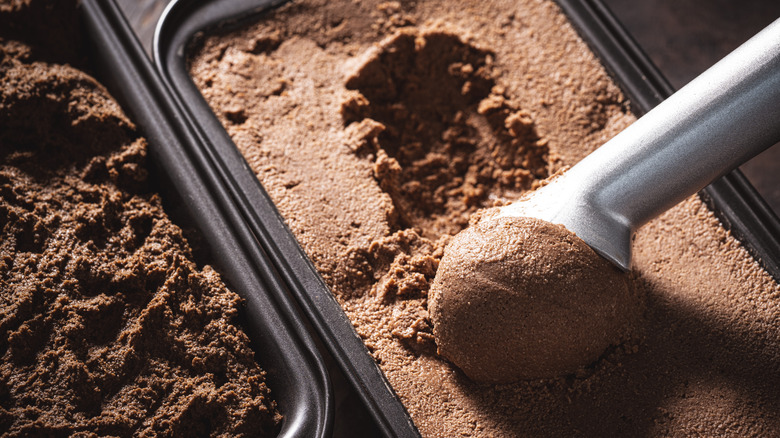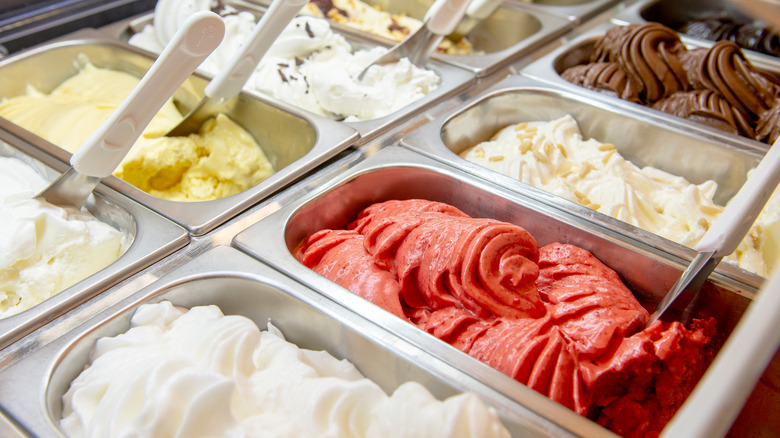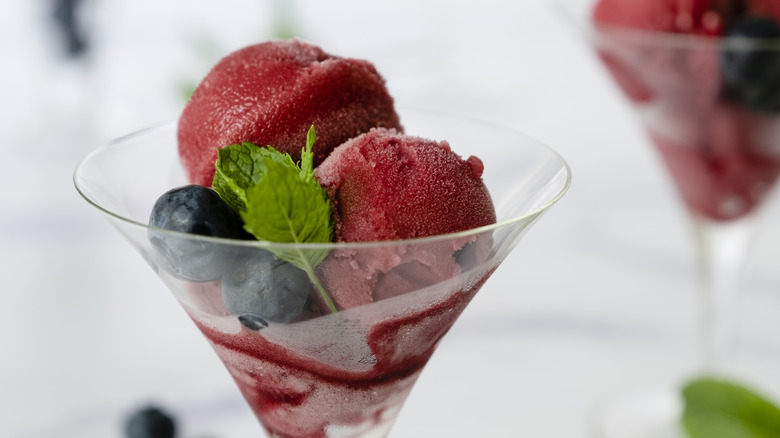How Gelato Really Differs From Ice Cream
Ice cream and its Italian cousin gelato might seem practically the same on first blush, but they actually contain a few key differences. The biggest one comes down to fat content. Ice cream, to begin with, has specific rules about how much butterfat (the amount of fat derived from cream and butter) it legally must contain. Per the USDA, ice cream must have a fat content minimum of 10%. Anything less than that may be labeled as a frozen dairy product or soft serve. Gelato does not have a minimum content and usually contains about 4% to 9% fat.
These two products diverge in the way they are made, as well. Ice cream is churned more quickly than gelato, which means more air gets incorporated into the dairy. Gelato tops out around 25% to 30% air — while ice cream can have upwards of 50%. This creates a lighter texture than dense gelato.
Egg yolks are also a crucial difference between these two frozen treats. While ice cream does not always contain egg yolks, it frequently does. Conversely, gelato rarely calls for yolks; when it does, it is in much smaller quantities than ice cream.
Differing tastes, temperatures, and textures
All of these differences have a dramatic impact on flavor. Because gelato has less fat (which can mask the taste by covering taste buds), its ingredients shine more brightly. A vanilla bean gelato, for example, will taste more like vanilla than an ice cream of the same flavor. The lower fat content also makes gelato sit more lightly on the palate.
Another reason gelato is more powerful than ice cream is temperature. Because fat doesn't freeze, ice cream is usually held at a lower temperature of around 0 degrees Fahrenheit. If gelato was kept this cold, it would freeze into an unappetizing block. Instead, the Italian dessert is held at roughly five and 14 degrees Fahrenheit to keep it smooth and creamy. The colder a food is, the more it numbs our taste buds. Therefore, the warmer temperature of gelato also makes it taste stronger than ice cream. At the same time, the warmer temperature also gives it a silky texture that ice cream only takes on as it warms up.
Differences between gelato, ice cream, and other frozen desserts
Gelato's bright taste and creamy texture may bring to mind frozen custard. Custard also contains less butterfat and has a more dense texture than ice cream, but egg yolks are the difference yet again. Custard must legally contain at least 1.4% egg yolks — or 1.12% if fruits or other ingredients are added. These yolks give it a chewy texture. Ice cream, for its part, may contain no more than 1.4% egg yolks. If you add a few too many yolks to a batch of homemade ice cream, you'll technically be making custard.
Sorbet, another dessert with a long tradition in Italy, differs from all dairy desserts because it omits milk, cream, or egg products entirely. Instead, sorbet leans on fruit juices and purees to form its backbone. This gives it a brighter taste and much less creamy texture than ice cream or gelato.
Finally, frozen yogurt is another cold treat with its own set of characteristics. While it also starts with the familiar base, frozen yogurt uses cultured milk, just like regular yogurt, rather than cream. This results in the dessert's characteristic tang, something missing from ice cream and gelato alike.



